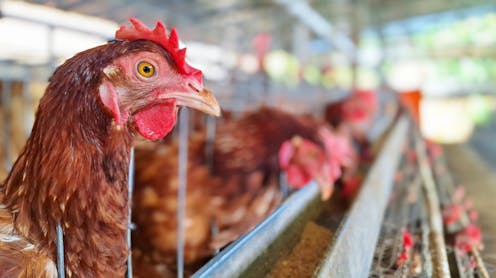Consumers want cage-free eggs, but Indonesian farmers say they need more support to do this
- Written by Kate Hartcher, Adjunct Lecturer at the School of Veterinary Science, The University of Queensland

With rising consumer concerns[1] for animal welfare worldwide, the poultry industry[2] is starting to let their hens roam around in bigger spaces. This shift from conventional battery cages to cage-free systems allow layer hens greater freedom of movement and a chance to engage in natural behaviours[3], from foraging to dust-bathing[4].
Indonesia, the second-largest egg producer worldwide[5], is also experiencing this transition, as many multinational and Asian food companies are committing to improving animal welfare standards and sourcing exclusively cage-free eggs by 2025[6].
But for farmers, the transition to cage-free eggs can be costly.
Our study[7] shed light on farmers’ perspectives across Asia on this transition to cage-free, with most survey respondents being from Indonesia. This research highlights the feasibility, challenges, and potential solutions to adopting the cage-free systems.
Why are cages a problem?
Historically, traditional free-range methods were widely used in poultry farming in Indonesia[8]. However, in the late 20th century[9], increasing population and economic demands led to the adoption of more industrialised farming techniques, including battery cages. These cages, first introduced in the United States and Europe, aimed to increase egg production efficiency but have been criticised for compromising the hens’ quality of life[10].
In battery cages, each hen is typically confined to a space of about 500 to 600 cm² per bird[11]. This limited space restricts their ability to move freely, spread their wings, or perform normal behaviours such as perching, nesting and dust bathing. This leads to various welfare issues[12].
Our research
Our study[13] investigated farmers’ views on the feasibility, challenges and potential solutions related to cage-free egg farming.
We surveyed 202 egg producers in Indonesia, China, Thailand, Japan, Malaysia, and the Philippines, with 108 of these in Indonesia. Of the 202 farmers, 165 used battery cages, while a smaller group of 37 had cage-free systems. The vast majority of hens in Indonesia are kept in battery cages (greater than 90%).
Our findings
Among all cage-free farmers polled (from all countries), we identified some key challenges.
The cost of production ranked as the biggest challenge, representing 22% of all responses to the question on this topic. This shows the economic issues that farmers have to think about as they make the switch. System management (14%) and disease prevention (14%) were also big issues, showing the transition can be complicated.
However, perhaps the most telling figure is the overwhelming majority of cage-free egg producers (81%) said they needed more support in maintaining their farms.
When we spoke with farmers who currently still use cages, they were optimistic about the prospect of cage-free systems (65% responded “yes” or “maybe” when asked if they consider cage-free systems to be feasible in their country). Howerver, they also reported [a need for more support] in the adoption of cage-free systems, in the form of technical advice, training and resources[14].
While there has been significant progress in the sourcing of cage-free eggs, these results may help explain the difficulty in finding cage-free eggs in Asia and the relatively low rate of procurement by food companies in the region.
Building support systems
We also asked farmers to suggest potential solutions to the challenges. Cage-free farmers told us “improving on-farm practices” was most important when it came to keeping their farms operating. This includes lowering expenses and raising production efficiency, as well as advice on establishing procedures, supplying the necessary resources, and enhancing best practices in flock management. The findings indicate a recognition among farmers that switching to cage-free systems requires changes not only in infrastructure but also farming practices.
Farmers also told us they needed better marketing. This means that the success of this transition depends on improved awareness of cage-free eggs in consumers. A solutions-oriented, co-designed approach will involve the relevant stakeholders, such as researchers, egg producers, companies, and international animal protection non-government organisations.
Farmers need more support
This study highlights some of the challenges that farmers face when adopting cage-free systems. Results imply that the most effective approach to address the concerns of egg producers and enable food companies to fulfil their cage-free commitments may be to provide information for producers in the form of education, training and resources[15] on cage-free systems to the egg industry. Examples of existing initiatives in the country are the University of Gadjah Mada’s [Cage-Free Innovation and Welfare Hub] in Yogyakarta, Indonesia.
Food companies could also support their egg producers by providing capacity building and training of their egg producers. Such support may help to improve the availability and the price of cage-free eggs in their local region.
As of today, sixteen companies[16] have fully transitioned to sourcing 100% cage-free eggs in Indonesia. Worldwide, there are 79 companies listed in Compassion in World Farming’s 2023 EggTrack Report, although only 56%[17] are reporting progress on their cage-free commitment.
As the egg industry addresses the challenges and moves forward with cage-free egg production across the region, our research shows that farmers need more support in the switch to cage-free to meet consumer expectations for more humane treatment in egg production.
References
- ^ With rising consumer concerns (www.frontiersin.org)
- ^ the poultry industry (www.foodbeverageinsider.com)
- ^ natural behaviours (www.cambridge.org)
- ^ foraging to dust-bathing (www.mdpi.com)
- ^ the second-largest egg producer worldwide (www.statista.com)
- ^ by 2025 (thehumaneleague.org)
- ^ study (www.cambridge.org)
- ^ were widely used in poultry farming in Indonesia (www.publish.csiro.au)
- ^ the late 20th century (jpi.faterna.unand.ac.id)
- ^ compromising the hens’ quality of life (welfarefootprint.org)
- ^ 500 to 600 cm² per bird (www.cambridge.org)
- ^ various welfare issues (www.cambridge.org)
- ^ study (www.cambridge.org)
- ^ the adoption of cage-free systems, in the form of technical advice, training and resources (www.frontiersin.org)
- ^ resources (globalfoodpartners.com)
- ^ sixteen companies (www.cagefreetracker.com)
- ^ only 56% (www.wattagnet.com)
Authors: Kate Hartcher, Adjunct Lecturer at the School of Veterinary Science, The University of Queensland





